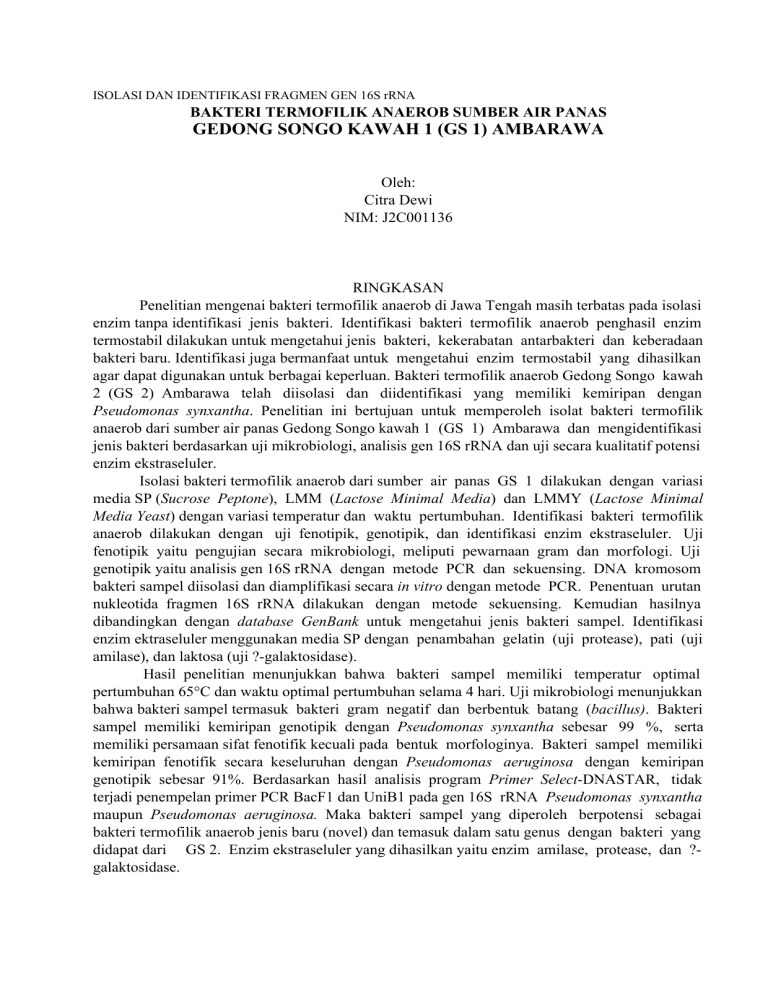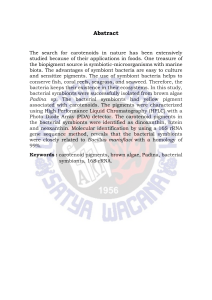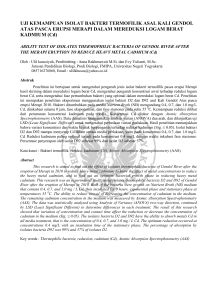ISOLASI DAN IDENTIFIKASI FRAGMEN GEN 16S rRNA
advertisement

ISOLASI DAN IDENTIFIKASI FRAGMEN GEN 16S rRNA BAKTERI TERMOFILIK ANAEROB SUMBER AIR PANAS GEDONG SONGO KAWAH 1 (GS 1) AMBARAWA Oleh: Citra Dewi NIM: J2C001136 RINGKASAN Penelitian mengenai bakteri termofilik anaerob di Jawa Tengah masih terbatas pada isolasi enzim tanpa identifikasi jenis bakteri. Identifikasi bakteri termofilik anaerob penghasil enzim termostabil dilakukan untuk mengetahui jenis bakteri, kekerabatan antarbakteri dan keberadaan bakteri baru. Identifikasi juga bermanfaat untuk mengetahui enzim termostabil yang dihasilkan agar dapat digunakan untuk berbagai keperluan. Bakteri termofilik anaerob Gedong Songo kawah 2 (GS 2) Ambarawa telah diisolasi dan diidentifikasi yang memiliki kemiripan dengan Pseudomonas synxantha. Penelitian ini bertujuan untuk memperoleh isolat bakteri termofilik anaerob dari sumber air panas Gedong Songo kawah 1 (GS 1) Ambarawa dan mengidentifikasi jenis bakteri berdasarkan uji mikrobiologi, analisis gen 16S rRNA dan uji secara kualitatif potensi enzim ekstraseluler. Isolasi bakteri termofilik anaerob dari sumber air panas GS 1 dilakukan dengan variasi media SP (Sucrose Peptone), LMM (Lactose Minimal Media) dan LMMY (Lactose Minimal Media Yeast) dengan variasi temperatur dan waktu pertumbuhan. Identifikasi bakteri termofilik anaerob dilakukan dengan uji fenotipik, genotipik, dan identifikasi enzim ekstraseluler. Uji fenotipik yaitu pengujian secara mikrobiologi, meliputi pewarnaan gram dan morfologi. Uji genotipik yaitu analisis gen 16S rRNA dengan metode PCR dan sekuensing. DNA kromosom bakteri sampel diisolasi dan diamplifikasi secara in vitro dengan metode PCR. Penentuan urutan nukleotida fragmen 16S rRNA dilakukan dengan metode sekuensing. Kemudian hasilnya dibandingkan dengan database GenBank untuk mengetahui jenis bakteri sampel. Identifikasi enzim ektraseluler menggunakan media SP dengan penambahan gelatin (uji protease), pati (uji amilase), dan laktosa (uji ?-galaktosidase). Hasil penelitian menunjukkan bahwa bakteri sampel memiliki temperatur optimal pertumbuhan 65°C dan waktu optimal pertumbuhan selama 4 hari. Uji mikrobiologi menunjukkan bahwa bakteri sampel termasuk bakteri gram negatif dan berbentuk batang (bacillus). Bakteri sampel memiliki kemiripan genotipik dengan Pseudomonas synxantha sebesar 99 %, serta memiliki persamaan sifat fenotifik kecuali pada bentuk morfologinya. Bakteri sampel memiliki kemiripan fenotifik secara keseluruhan dengan Pseudomonas aeruginosa dengan kemiripan genotipik sebesar 91%. Berdasarkan hasil analisis program Primer Select-DNASTAR, tidak terjadi penempelan primer PCR BacF1 dan UniB1 pada gen 16S rRNA Pseudomonas synxantha maupun Pseudomonas aeruginosa. Maka bakteri sampel yang diperoleh berpotensi sebagai bakteri termofilik anaerob jenis baru (novel) dan temasuk dalam satu genus dengan bakteri yang didapat dari GS 2. Enzim ekstraseluler yang dihasilkan yaitu enzim amilase, protease, dan ?galaktosidase. SUMMARY The researches on anaerob thermophilic bacteria in Central Java are only limited to enzyme isolation without species bacteria identification. The identification of anaerob thermophilic bacteria which produce thermostable enzyme is to know species of bacteria, bacteria phylogeny, and novel bacteria. The identification is also aimed to know the termostable enzyme produced that applicable for any applications. Anaerob thermophilic bacteria from Gedong Songo hot spring 2 (GS 2) Ambarawa had been isolated and identified that the bacteria is similar with Pseudomonas synxantha. The purpose of this research is to get the isolate from Gedong Songo hot spring 1 (GS 1) Ambarawa and to identify the species of bacteria based on microbiology test, 16S rRNA gene analysis and qualitative extracelluler enzyme identification. Isolation of anaerob thermophilic bacteria from Gedong Songo hot spring 1 (GS 1) Ambarawa had been done in SP (Sucrose Peptone), LMM (Lactose Minimal Media) and LMMY (Lactose Minimal Media Yeast) medium with variation of temperature and time of living, followed by phenotypic and genotypic test, and extracelluler enzyme identification. Before genotific test, sampel bacteria’s chromosomal DNA was isolated and in vitro amplified with PCR method. Nucleotide sequences from 16S rRNA fragment were determined with sequencing method. Then the result were compared with those in database from GenBank to identify bacteria’s species sample. Extracelluler enzyme identification used SP medium with adding gelatin (protease test), starch (amylase test) and lactose (?-galactosidase test). The result of research showed that sample of bacteria had optimum growth temperature of 65°C and optimum growth at 4 days. Microbiology test showed that bacteria sample was gram’s negative and had bacillus shape. Bacteria sample had 99% genotype similarity with Pseudomonas synxantha and had phenotypic similarity except the morphology shape. Sample bacteria had all phenotypic similarity with Pseudomonas aeruginosa and had 91% genotype similarity. Based on analysis of Primer Select-DNASTAR program, there are no anneal side BacF1 and UniB1 PCR primer compatible at 16S rRNA gene of Pseudomonas synxantha and Pseudomonas aeruginosa. Therefore the sample bacteria had a potency as novel thermophilic anaerobic bacteria and it had same genus with bacteria from GS 2. Extracelluler enzymes produced were amylase, protease, and ?-galactosidase enzymes. DAFTAR PUSTAKA Agullo, M., 1955, “Studies of The Biosynthesis of Extracellular Proteases by Bacteria”, Journal of General Physiology. Ajayi, A. O., and Fagade, O. E., 2003, “Utilization of Corn Strach As Substart for ?-Amylase by Bacillus sp.”, African Journal of Biomedical Research, Vol. 6, No. 1, 37-42. Alimang, C., Marylene, M., Eric, W., Bernard, E., and Chantal, E., 1994, “Role of Conserved Nucleotides in Building the 16S rRNA Binding Site of E. Coli Ribosomal Protein”, Nucleic Acid Research, Vol.28, No. 18. Andres, 1999, “Stability of Biocatalysis”, Electronic Journal of Biotechnology, Vol. 2 No. 1, Issue of April 15. Bartholomew, J., Thomas, C., and Richard, G., 1965, “Analysis of The Mechanism of Gram Differentiation by Use of A Filter Chromatographic Technique”, Journal of Bacteriology, Vol. 90, No. 3. Bavykin, S.G., Lysov, Y.P., Zakhariev, V., Kelly, J.J., Jackman, J., Stahl, D.A., and Cherni, A., 2004, “Use of 16S rRNA, 23S rRNA and gyr B Gene Sequence Analysis To Determine Phylogenetic Relationship of Bacillus cereus Group Microorganism”, J. Clin. Microbiol., 42 (8), 3711-1730. Beveridge, T.J., 1999, “Structure of Gram-Negative Cell Wall and Their Derived Membrane Vesicles”, J. Bacteriol., 181, 4725-4733. Brock, 1979, “Biology of Microorganisms”, third edition, Prentice-Hall Inc., New Jersey. Brow, M.A.D., 1990, “Sequencing with Taq DNA polymerase”, in Innis et al., PCR Protocols A Guide to Methods and Applications, Academic Press, Inc, San Diego, California, 189205. Brown, T.A., 1995, “Gene Cloning: An Introduction”, third edition, Chapman and Hall, 10, 192200. Bruins, M., Anjae, M., and Andenikom, B., 2001, “Thermoenzyme and Their Application”. Applied Biochemistry and Biotechnology, Vol. 90. Carman, D.R., 2001, “Bacterial Characteristic: Introduction to Bacteriology”, Micro., 6: 11-23. Castro-Escarpulli, G., Figueras, M.J., Aguilera-Arreola, G., Soler., L., Fernandez-Rendon, E., Aparicio, G.O., Guarro, J., and Chacon, M.R., 2003., “Characterisation of Aeromonas spp. Isolated from Frozen Fish Intended for Human Consumption in Mexico”, Int. J. Food Microbiol., 41-49. Choi, J.J., Oh, E.-J., Lee, Y.-J., Suh, D.S., Lee, J.H., Lee, S.-W., Shin, H.-T., and Kwon, S.T., 2003, “Enhanced Expression of the Gene for ?-Glycosidase of Thermus caldophillus GK24 and Synthesis of Galacto-oligosaccharides by The Enzyme”, Biotechnol. Appl. Biochem., 38, 131-136. Curi, R., Ligia, S., Monica, R., and Catalina, R., 2002, “Bovine Carcass Sexing by PCR Method”, Brazilian Journal of Veterinary Research and Animal Science, Vol. 39, No. 3. Dabboussi, F., Hamze, M., Elomari, M., Verhille, S., Baida, N., Izard, D., and Leclerc, H, 1999, “Pseudomonas libanensis sp. nov., A New Species Isolated from Lebanese Spring Waters”, International Journal of Systematic Bacteriologi, 49, 1091–1101. Drouoult, S., Jamila, A., and Gerard, C., 2002, “Streptococcus thermophilus is Able to Produce A ?-Galactosidase Active During Its Transit in The Digestive Tract of Germ-Free Mice”, Applied and Environtmental Microbiology, Vol. 68, no. 2, 938-941 Fouke, B.W., 2000, “Extraction of Microbial 16S rRNA Gene Sequences from Hot Spring Travertine”, Department of Geology, UIUC Friedman, S.M., 1992, “Thermophilic Microorganism”, Encyclopedia of Microbiology, Vol 4, Academic Press Inc, 217-219. Ginayani, A., 2006, “Identifikasi Fragmen Gen 16S rRNA pada Bakteri Termofilik Anaerob Hasil Isolasi dari Sumber Air Panas Gedong Songo Ambarawa Jawa Tengah”, Skripsi, FMIPA Kimia, Universitas Diponegoro. Gokce, N., Hollocher, T.C., Bazylinski, D.A., and Jannasch, H.W., 1989, “Thermophilic Bacillus sp. That Shows the Denitrification Phenotype of Pseudomonas aeruginosa”, Applied and Environtmental Microbiology, Vol. 55, no. 4, 1023-1025. Innis, M.A., Gelfand, D.H., Sninsky, J.J., and White, T.J., 1990, PCR Protocols A Guide to Methods and Applications, Academic Press Inc., San Diego, California, 3-4 Irwin, J.A., and Baird, A.W., 2004, “Extremophiles and Their Application to Veterinary Medicine”, Irish Vetenary Journal, 57 (6), 348-354. Jeanthon, C., L’Haridon, S., Cueff, V., Banta, A., Reysenbach, A., and Prieur, D., 2002, “Thermodesulfobacterium hydrogeniphilum sp. nov., A Thermophilic, Chemolithoautotropic, Sulfate-Reducing Bacterium Isolated from A Deep-Sea Hydrothermal Vent at Guaymas Basin and Emendation of Genus Thermodesulfobacterium”, Int. J. Syst. Evol. Microbiol., 52, 765-772 Klijn, N., Weerkamp, A.H., and De Vos, W.M., 1991, “Identification of Mesophilic Lactic Acid Bacteria by Using Polymerase Chain Reaction-Amplified Variable Regions of 16S rRNA and Spesific DNA Probes”, App. Environ. Microbiol., 57, 3390-3393 Kong, Q.X., Wang, X.W., Jin, M., Shen, Z.Q., and Li, J.W., 2006, “Development and Application of a Novel and Effective Screening Method for Aerobic Denitrifying Bacteria”, FEMS Microbiol Lett., 260(2), 150-155. Kruczak-Fillipov, P. and Shively R., 1992, ”Gram Stain Procedure”, Clinical Microbiology Procedures Handbook, Vol 1, 1.5.1.-1.5.1.8 Kurahashi, M., and Yokota, A., 2006, “Endozoicimonas elysicola gen. nov., sp. nov., a GammaProteobacterium Isolated from the Sea Slug Elysia ornata”, Syst Appl Microbiol., Issue of Aug 9. Kwon, S., Go, S., Kang, H., Ryu, J., and Jo, J., 1997, Phylogenetic Analysis of Erwinia species Based on 16S rRNA Gen Sequences, Int. J. Syst. Bacteriol., 47, 1061-1067 Kwon, S.W., Kim, J.S., Crowley, D.E., and Lim, C.K., 2005, “Phylogenetic Diversity of Fluorescent Pseudomonads in Agricultural Soils from Korea”, Letters in Applied Microbiology, 41, 417-423. Levett, P.N., 1957, “Anaerobic Bacteria: A Functional Biology”, Open University Press, Philadelphia, 1-17. Lewin, B., 1998, “Genes VI”, Oxford University Press, USA. Matzinger, 2004, “The Importance of 16S rRNA Bacterial Spore Identification”, Vol. 1. No. 6. McClelland, R., 2001, “Gram’s Stain: The Key to Microbiology”, MLO: www.mlo-online.com, 2028 McDermott, Dr. Timothy, 2001, “Characterization of the Microbial Rhizosphere Population of Acid and Thermotolerant Grasses Associated with Hot Springs and Microbial Diversity in Thermal Soils in YNP”, Yellowstone National Park, 129. McLean, Jeff S., Beveridge, Terry J., and Phipps, D., 2000, “Isolation and Characterization of a Chromium-Reducing Bacterium from a Cromated Copper ArsenateContamined Site”, Environmental Microbiology, 2(6), 611-619. Moeini, H., Iraj, N., and Manoochehr, T., 2004, “Improvement of SCP Production and BOD Removal of Whey with Mixed Yeast Culture”, Electronic Journal of Biotechnology, Vol. 7, No. 3. Newman, J.D., 2001, “Ribosomal RNA Gene Amplification and Sequencing to Identify Unknown Microbes”, Lycoming College, Williamsport, PA 17701 Old, R.W., and Primrose, S.B., 1994, “Principle of Gene Manipulation An Introduction to Genetic Engineering”, fifth edition, Blackwell Scientific Publication, Oxfod. Parvaresh, F., Gabin, V. I. C., Thomas, D., and Legoy, M. D., 1990, Uses and Potentialities of Thermostabil Enzymes, Enzyme Engineering 10, The New York Academy of Sciences, New York, 303-305 Pestova, E. V., and Morisson, D.A., 1998, “Isolation and Characterization of Three Streptococcus pneumoniae Transformation-Specific Loci by Use of lacZ Reporter Insertion Vector”, Bacteriol., 180 (10), 2701-2710. Pinar, G., and Ramos, J.L., 1998, “A Strain of Arthrobacter the Tolerates High Concentrations of Nitrate”, Biodegradation, 8, 393-399. Pirttila, Anna M., Joensuu, P., Pospiech, H., Jalonen, J., and Hohtola, A., 2004, “But Endophytes of Scots Pine Produce Adenine Derivatives and Other Compounds That Affect Morphology and Mitigate Browning of Callus Cultures”, Physiologia Plantarum, 121(2), 305-312. Rao, M.B., Tanskale, A.M., Ghatge, M.S., and Deshpande, V.V., 1998, “Molecular and Biotechnological Aspects of Microbial Proteases”, Microbiol. Mol. Biol. Rev., 62 (3), 597-635. Reiter, B., and Sessitsch, A., 2006, “Bacterial Endophytes of the Wildflower Crocus albiflorus Analyzed by Characterization of Isolates and by a Cultivation-Independent Approach”, 52 (2), 140-149. Sacci, C.T., Whitney, A.M., Mayer, L.W., Morey, R., Steigerwalt, A., Boras, A., Meyant, R.S., and Popovic, T., 2002, Sequencing of 16S rRNA Gene: A Rapid Tool for Identification of Bacillus Anthracis, Vol. 8, No. 1. Sambrook, J. and Russell, D.W., 2001, Molecular Cloning a Laboratory Manual, third edition, Cold Spring Harbor Laboratory Press, New York. Shaw, J., Fu-Pang, Su-Chiu, and Hsing, C., 1995, “Purification and Properties of An Extracelluler Alpha-Amilase from Thermus sp.”, Bot. Bull. Acad. Sin. 36: 195-200. Shich, W.Y. and Jean, W.D., 1998, “Alterococcus Agarolyticus, ge.nov., sp.nov., A Halophilic Thermophilic Bacterium Capable of Agar Degradation”, Can. J. Microbiol./Rev. can. Microbiol. 44 (7): 637-645. Silipo, A., Lanzetta, R., Garozzo, D., Cantore, P.L., Iacobellis, N.S., Molinaro, A., Parrilli, M., and Evidente, A., 2002, “Structural Determination of Lipid A of The Lipopolysaccharide from Pseudomonas reactan”, Eur.J.Biochem., 269, 2498-2505. Stratchan, T. and Red, A.P., 1999, Human Molecular Genetics, second edition, Wiley-Liss, A John Wiley and Sons Inc. Publication, Oxford, 120-137. Suprapti, H.Y., 2005, “Identifikasi Fragmen Gen 16S rRNA Bakteri Termofilik Hasil Isolasi dari Sumber Air Panas Gedong Songo”, Skripsi, FMIPA Kimia, Universitas Diponegoro. Takai, K., Yoshihiko, S., and Aritsune, U., 1998, “Acqiured Thermotolerance and Temperature–Induced Protein Accumulation in The Extremely Thermophilic Bacterium Rhodothermus obamensis”, J. Bacteriol., Vol. 180, No. 10, hal. 2770-2774. Thomassin-Lacroix, E.J.M., Yu, Z., Eriksson, M., Reimer, K.J., and Mohn, W.W., 2001, “DNABased and Culture-Based Characterization of a Hydrocarbon-Degrading Consortium Enriched from Artic Soil”, Can.J. Micribiol, 47 (12), 1107-1115. Todar, K., 2004, “Pseudomonas aeruginosa”, Todar’s Online Textbook of Bacteriology, University of Wisconsin-Madison Department of Bacteriology. Trent, J., Mette, G., Bo, J., Jan, N., and Jorgen, O., 1994, “Acqiured Thermotolerance and Heat Sock Protein in Thermophiles from The Tree Phylogenetic Domains”, Journal of Bacteriology, Vol. 176, No. 19, 6248-6152. Van Holde, K.E., Johnson, W.C., and Shing Ho, P., 1998, Principles of Physical Biochemistry, Prentice Hall, New Jersey, 213-221. Webster, G., Watt, L.C., Rinna, J., Fry, J.C., Evershed, R.P., Parkes, R.J., and Weightman, A.J., 2006, “A Comparison of Stable-Isotope Probing of DNA and Phospholipid Fatty Acids to Study Prokaryotic Functional Diversity in Sulfate-Reducing Marine Sediment Enrichment Slurries”, Environ. Microbiol., 8 (9), 1575-1589. Wise, M.G., McArthur, J.V., and Shimkets, L.J., 1997, “Bacterial Diversity of Carolina Bay as Determined by 16S rRNA Gene Analysis: Confirmation of Novel Taxa”, App. Environ. Microbiol.,1505-1514 Whitfield, J.B., 2004, “Molecular Phylogeny: Born in A Commune”, Nature, 427-674. Woodson, S.A. and Leontis, N.B., 1998, “Stucture and Dynamics of Ribosomal RNA”, Curr. Opin. Struct. Biology, 8, 294-300

